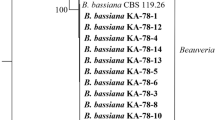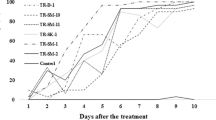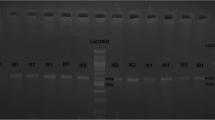Abstract
Larvae of the cedar web-spinning sawfly, Cephalcia tannourinensis Chevin (Hymenoptera: Pamphiliidae), infected with a white fungus were collected from the Tannourine-Hadath El-Jebbeh cedar forest. Macro- and micro-morphological data based on the examination of colonies, conidiophores, and conidial shape of the fungus suggested a Beauveria species. Sequence analysis of the internal transcribed spacer regions of the isolated fungus showed that it is most closely related to isolates of B. bassiana Clade C. The present study showed that the isolated B. bassiana is a naturally occurring entomopathogenic fungus parasitizing the larvae of C. tannourinensis in Lebanon. Laboratory bioassays showed that B. bassiana caused high mortality of eggs and larvae. The infected eggs turned brownish in color, while larvae of the first instar ceased feeding and showed immobility and rigidity within 5 days and before sporulating conidial mat appeared on their cuticle. Second and third larval instars took longer time to show fungal sporulation: mortalities ranged between 85 and 100% within 7 days when treated with different conidial concentrations. The efficacy of control of C. tannourinensis using B. bassiana was higher or equal to the reference insect growth regulator, diflubenzuron, suggesting the possibility of its success as a biological control agent.

Similar content being viewed by others
References
Abbott WS (1925) A method of computing the effectiveness of an insecticide. J Econ Entomol 18:265–267
Battisti A (1994) Effects of entomopathogenic nematodes on the spruce web-spinning sawfly Cephalcia arvensis Panzer and its parasitoids in the field. Biocontrol Sci Technol 4:95–102
Boucias D, Pendland J (1998) Principles of insect pathology. Kluwer Academic Publishers, Boston
Brady BLK (1979) Beauveria bassiana and Beauveria brongniartii. CMI descriptions of pathogenic fungi and bacteria 1964–1995. Common Wealth Mycological Institute, Kew, England
Brockerhoff EG, Kenis M, Turgeon JJ (2002) Cydia strobilella (L.), spruce seed moth (Lepidoptera: Tortricidae). In: Mason PG, Huber JT (eds) Biological control programmes in Canada. CABI Publishing, Wallingford, Oxon, UK, pp 1981–2000
Chevin H (2002) Cephalcia tannourinensis n. sp., nouveau ravageur du Cèdre du Liban (Hymenoptères Pamphiliidae). L’Entomologiste 58:241–242
FAO (1993) Mission report in Lebanon. Technical Cooperation Program. TCP/LEB/2251
Feng MG, Poprawski TJ, Khachatourians GG (1994) Production, formulation and application of the entomopathogenic fungus Beauveria bassiana for insect control: current status. Biocontrol Sci Technol 4:3–34
Fischer P (1996) The entomoparasitic nematode species Steinernema feltiae (Nematoda: Steinernematidae) as a mortality factor of the spruce webworm Cephalcia abietis (Hym: Pamphiliidae). Entomol Generalis 21:107–115
Glare T, Inwood A (1998) Morphological and genetic characterisation of Beauveria spp. from New Zealand. Mycol Res 102:250–256
Hicks B, Watt A, Cosens D (2001) The potential of Beauveria bassiana (Hyphomycetes: Moniliales) as a biological control agent against the pine beauty moth, Panolis flammea (Lepidoptera: Noctuidae). For Ecol Manag 149:275–281
Humber R (1997) Fungi: identification. In: Lacey LA (ed) Manual of techniques in insect pathology. Academic, San Diego, pp 153–163
Konstantopoulou MA, Mazomenos BE (2005) Evaluation of Beauveria bassiana and B. brongniartii and four wild-type fungal species against adults of Bactrocera oleae and Ceratitis capitata. BioControl 50:293–305
Larone DH (1995) Medically important fungi: a guide to identification. Elsevier, New York
Maurer P, Rejasse A, Capy P, Langin T, Riba G (1997) Isolation of the transposable element hupfer from the entomopathogenic fungus Beauveria bassiana by insertion mutagenesis of the nitrate reductase structural gene. Mol Gen Genet 256(2):195–202
Moore D, Prior C (1993) The potential of mycoinsectides. Biocontrol News Inf 14(2):31–40
Nemer N, Nasr J (2004) Saving the cedars of Lebanon. Biocontrol News Inf 25(1):9N–11N
Nemer N, Demolin G, Kawar N, Kfoury L, Zakhour E (2005) Monitoring of the new cedar web-spinning sawfly, Cephalcia tannourinensis n. sp. in cedar forests of Lebanon. In: Lieutier F, Ghaioule D (eds) Entomological research in Mediterranean forest ecosystems. INRA Publications, Paris, pp 247–255
Rehner SA, Buckley E (2005) A Beauveria phylogeny inferred from nuclear ITS and EF1-α sequences: evidence for cryptic diversification and links to Cordyceps teleomorphs. Mycologia 97(1):84–98
Steinhaus EA (1947) Insect microbiology. Comstock Publishing, Ithaca
Thomas KC, Khachatourians GG, Ingledew WM (1987) Production and properties of Beauveria bassiana conidia cultivated in submerged culture. Can J Microbiol 33:12–20
Wang S, Miao X, Zhao W, Huang B, Fan M, Li Z, Huang Y (2005) Genetic diversity and population structure among strains of the entomopathogenic fungus, Beauveria bassiana, as revealed by inter-simple sequence repeats (ISSR). Mycol Res 102:250–256
Zhang YP, Uyemto JK, Kirkpatrick BC (1998) A small scale procedure for extracting nucleic acids from woody plants infected with various phytopathogens for PCR assays. J Virol Methods 71:45–50
Acknowledgments
The authors acknowledge Ms Gillian Allard, Forestry Officer at the Food and Agricultural Organization of the United Nations for her initial identification of Beauveria and supplying all relevant information to initiate the study. Cultures of strains of Beauveria for molecular analysis were obtained from the USDA-ARS Collection of Entomopathogenic Fungal Cultures (ARSEF, Ithaca, NY, USA); with thanks to Dr Richard A. Humber, curator, and Karen S. Hansen, Biological Technician. Part of this work was partially funded by the Lebanese National Council for Scientific Research. The technical assistance of Ms Maya Nehmé, Ms Hana Sobh, Ms Lucy Hanna, and Mr Shoaa El Mehtar is appreciated.
Author information
Authors and Affiliations
Corresponding author
Rights and permissions
About this article
Cite this article
Abdo, C., Nemer, N., Nemer, G. et al. Isolation of Beauveria species from Lebanon and evaluation of its efficacy against the cedar web-spinning sawfly, Cephalcia tannourinensis . BioControl 53, 341–352 (2008). https://doi.org/10.1007/s10526-006-9062-0
Received:
Accepted:
Published:
Issue Date:
DOI: https://doi.org/10.1007/s10526-006-9062-0




